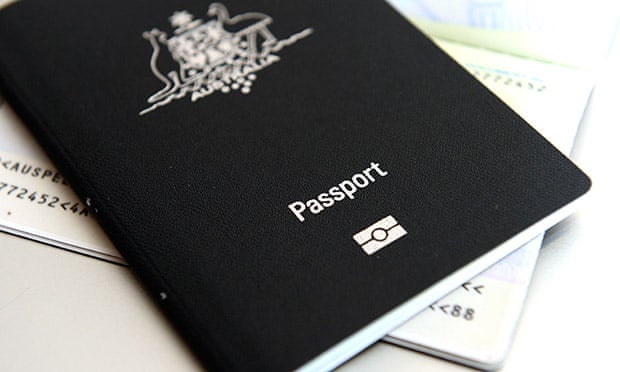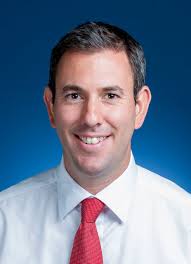Intergenerational report: assumptions about government spending are a confusion of idiocy
The report happily assumes that the government would not change any
spending policy for 40 years and debt by 2055 would reach 122% of GDP

The intergenerational report estimates net overseas migration will grow by 215,000 per year. Photograph: Dan Peled/AAP
The
Intergenerational report released on Thursday is a document so weighed
down with imagined economic assumptions made for partisan political
reasons that it is barely worth reading, let alone being the basis of a
“conversation” with the Australian people about the next 40 years.
Intergenerational reports are always political documents, but they are not supposed to be partisan. Joe Hockey,
betraying perhaps an insecurity about his own performance as treasurer,
has decided to act as though he were in opposition and has made the
report as much about kickingLabor’s economic performance than attempting
to paint a picture of the challenges for the next 40 years.
Every intergenerational report is only as good as the assumptions on
which the predictions are based – especially those pertaining to
demographics. And while some of the predictions about the ageing
population and the implications that will have on employment
participation and economic growth are worth considering, the assumptions
about government spending over the next 40 years are pretty much a
farrago of idiocy.
For no good reason whatsoever, Hockey has decided for the first time
to include in the report projection based on policies of the former
government. But he takes as the ALP’s “previous policy” that represented
in the 2013-14 mid-year economic and fiscal outlook(Myefo)
– a document produced by the Abbott government and which saw the
2013-14 deficit increase by $10.26bn due to “policy decisions” taken by
the Abbott government.
The
2013-14 Myefo was itself designed to make it appear the ALP had blown
the budget, and thus using that as the starting point to predict budget
deficits over the next 40 years is a fairly dodgy exercise.
But from this beginning, the report happily assumes that under the
scenario the government would not change any spending policy for 40
years, debt by 2055 would reach 122% of GDP.
Yeah, right.
To get to that figure, not only does it assume there will be no
changes in spending, but even more stupidly, that while the deficit grew
ever more over the next 40 years, governments would be cutting income
taxes at the same time.
As Jeanie Bueller would say, dry that one out and you could fertilise the lawn.
The report estimates that from 2020-21 tax rates will be capped at “a
constant 23.9% of GDP”. This level was picked because it was the
“average of the period 2000-01 to 2007-08”. Why this seven year period
was chosen for the average however is left unsaid.
To keep the tax ratio at that level in the face of increasing wages,
which would see income tax receipts rise, the report implicitly suggests
taxes would be cut – all the while debt rises to 122% of GDP?
Yeah ok, seems legit.
There is no logical reason to keep the tax rate fixed at 23.9%. There
is no optimal level of taxation. If we look across advanced economies
from 2001 to 2007, Australia’s level of taxation across all forms of
government was quite low:
That this arbitrary tax level is chosen just highlights the political
nature of this document. It does not suggest that if government
expenditure is growing that revenue must grow to match – but rather that
expenditure must be cut.
It also ignores some quite massive social implications.
Nowhere is inequality mentioned, despite the report assuming that
Newstart will rise only by CPI for the next 40 years, while average
weekly earnings are assumed to rise by 1.5% above inflation.
This would see those on Newstart in 2055 receiving around 10% of average earnings, compared with around 17% now, and just below 25% in 1990.
It also dismisses climate change as no big thing.
Absurdly it contains no budgetary or economic impacts of climate
change beyond 2020, and the document is at pains to make it clear one
nation cannot change the climate.
The report enters levels of satire when it boasts (without any
evidence) that the government’s Emissions Reduction Fund will achieve
“verified domestic emissions reductions through incentives” rather than
simply drive “domestic production offshore — a process which would cost
Australian jobs for no decrease in global emissions”.
Oddly however, given the government specifically compares the impact
of the ALP policies in the 2013-14 Myefo with its own current policies,
it doesn’t compare the costs and impacts of the carbon tax with direct
action out to 2055 – perhaps because after 2020 the government hopes
climate change will go away.
The report also suggests that “some economic effects (of climate
change) may be beneficial – where regions become warmer or wetter this
may allow for increased agricultural output – while others may be
harmful”.
Ahh wonderful – a perfect balance!
The economic growth projections which underpin the assessments about
budget deficits are based on some pretty odd assumptions about
population, participation and productivity growth.
The history of the assumption of net migration over the four
intergenerational reports highlights just how rubbery these “40 year”
predictions can be. Every report has increased the assumption of net
migration over that in the previous report. This year’s report is no
different, but the figure it used remains well below what is the likely
outcome.
Migration is a very important aspect for predicting the next 40
years. The main challenge we face is an ageing population in which there
will be fewer prime working age people for every person retired. It
means our labour participation rates will fall because a smaller
percentage of the adult population will be working.
We’re already seeing this happen. In December 2010 a record high
67.7% of the adult population was participating in the labour force – it
is now 64.7%. In that time the participation rate of workers aged 25-64
is actually holding up quite well. But they make up less of the
population than they used to:
When predicting population growth you use two methods – fertility rate, and migration.
A high fertility rate is actually a cost on the economy and the
budget in the near term because children don’t work. Migrants however,
as the report make clear, “tend to be younger, on average, than the
resident population” and they “increase overall labour force
participation rates.”
The report also notes that “high levels of net overseas migration
might increase productivity, as the skills focus of Australia’s
migration program means that migrants may, on average, be better
educated than the average Australian”.
This is important because higher productivity is one of the great drivers of a higher standard of living.
The intergenerational report estimates net overseas migration (the
number of migrants minus the number of Australians leaving) over the
next 40 years will grow by 215,000 per year. That figure is higher than
the 180,000 estimated in the 2010 report, well above the 110,000
estimated in the 2007 report and miles above the 90,000 estimated in the
first report in 2002.
But even the 215,000 is below what the ABS estimates in its population projections. The median population projection assumed currently by the ABS is for 240,000 migrants a year.
It’s also worth noting that the Department of Immigration estimates net migration to increase from 225,800 last to 256,900 in 2018.
The report even estimates from 2007-2018 annual migration will be the
equivalent of 1.1% of the population, but will then for reasons unknown
fall to just over 0.5% from then till 2055.
The report notes that this 0.5% level was the average observed
between 1973 and 2006. Why that 33-year period suddenly became an
important benchmark for migration levels is unsaid. Why not the past 40
years? Why not 2001-2007 as was the case for tax?
The report thus assumes that in the face of an ageing population,
Australian governments would shrink the real migration intake – even
though that would exacerbate the problem!
The only reason you would make such an assumption is if you wanted to
be able to paint a picture of slowing growth, falling participation,
rising debt and deficits and weak economic growth – exactly the picture
Joe Hockey wants to suggest would have been the case under an ALP
government. And exactly the picture he wants to paint in order to
justify his proposed cuts to government expenditure.
To demonstrate how absurd this suggestion is, the report even notes
that if the net migration intake was estimated at 250,000 per year (i.e.
still less than is expected in 2018), then the improvement in real
gross national income per person by 2055 would be the same as if the
report assumed the unemployment rate for the next 40 years was 4%
instead of 5%.
On ABC’s AM
program, Hockey suggested “Immigration is, you know, is a rather lazy
way to try and grow your economy. What we’ve got to do is increase our
output per hour.”
Yes we do need to increase our productivity, but given immigration
can assist with that Hockey is in essence arguing that we should ignore
that solution in favour of a tougher one!
Joe Hockey asserted in the past month that the report would make
people “fall off their chairs”. It shouldn’t. There’s nothing
particularly scary in it, and as the report itself notes, “the
projections in this report are very unlikely to unfold over the next 40
years exactly as outlined. Things will happen that are not anticipated
in the report’s assumptions, and government policy will change.”
Indeed. By 2055, this report will be nothing but an odd curio from our political history.















